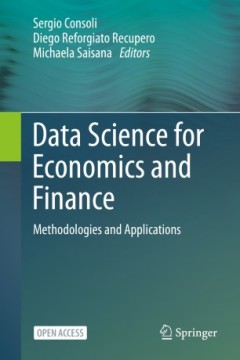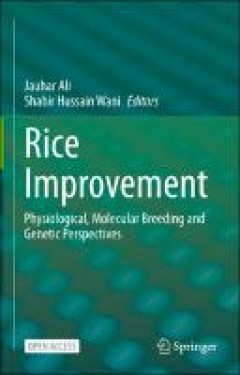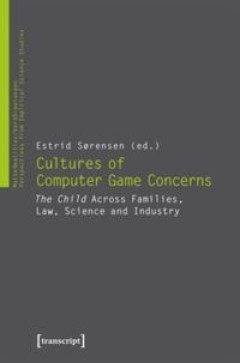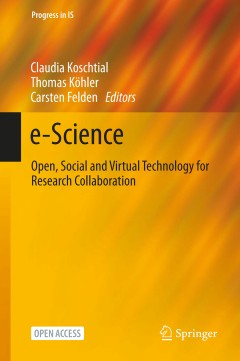Filter by

Public administration in Germany
This open access book presents a topical, comprehensive and differentiated analysis of Germany’s public administration and reforms. It provides an overview on key elements of German public administration at the federal, Länder and local levels of government as well as on current reform activities of the public sector. It examines the key institutional features of German public administration…
- Edition
- -
- ISBN/ISSN
- 9783030536978
- Collation
- xxiv, 416p. : ill.
- Series Title
- -
- Call Number
- 351.43 PUB p

Data science for economics and finance : methodologies and applications
This open access book covers the use of data science, including advanced machine learning, big data analytics, Semantic Web technologies, natural language processing, social media analysis, time series analysis, among others, for applications in economics and finance. In addition, it shows some successful applications of advanced data science solutions used to extract new knowledge from data in…
- Edition
- -
- ISBN/ISSN
- 9783030668914
- Collation
- xiv, 355p. : ill.
- Series Title
- -
- Call Number
- 006.312 DAT d

Occult roots of religious studies: on the Influence of non-hegemonic currents…
The historiographers of religious studies have written the history of this discipline primarily as a rationalization of ideological, most prominently theological and phenomenological ideas: first through the establishment of comparative, philological and sociological methods and secondly through the demand for intentional neutrality. This interpretation caused important roots in occult-esoteric…
- Edition
- -
- ISBN/ISSN
- 9783110664270
- Collation
- XII, 283 p.
- Series Title
- -
- Call Number
- 201.5 OCC o
International rainwater catchment systems experience
Harvesting rain and using it for drinking and domestic use will help to give scattered rural households and under-served city dwellers access to water. The world cannot ignore using rain - as the source of all water. This book presents stories and experiences from some 15 countries from all over the globe, developed and less developed. There are many more experiences that can be highlighted, bu…
- Edition
- -
- ISBN/ISSN
- 9781789060584
- Collation
- xxiii, 245p.: ill.
- Series Title
- -
- Call Number
- 628.142 INT i

Microorganisms in the deterioration and preservation of cultural heritage
This open access book offers a comprehensive overview of the role and potential of microorganisms in the degradation and preservation of cultural materials (e.g. stone, metals, graphic documents, textiles, paintings, glass, etc.). Microorganisms are a major cause of deterioration in cultural artefacts, both in the case of outdoor monuments and archaeological finds. This book covers the microorg…
- Edition
- -
- ISBN/ISSN
- 9783030694111
- Collation
- XII, 367 p.
- Series Title
- -
- Call Number
- 561.9 MIC m

The Persistence of memory: remembering slavery in Liverpool, 'slaving capital…
The Persistence of Memory is a history of the public memory of transatlantic slavery in the largest slave-trading port city in Europe, from the end of the 18th century into the 21st century; from history to memory. Mapping this public memory over more than two centuries reveals the ways in which dissonant pasts, rather than being ‘forgotten histories’, persist over time as a contested publi…
- Edition
- -
- ISBN/ISSN
- 9781789622577
- Collation
- xvi, 306p.: ill.
- Series Title
- -
- Call Number
- 306.3620942753 MOO p

Rice improvement: physiological, Molecular Breeding and Genetic perspectives
This book is open access under a CC BY 4.0 license. By 2050, human population is expected to reach 9.7 billion. The demand for increased food production needs to be met from ever reducing resources of land, water and other environmental constraints. Rice remains the staple food source for a majority of the global populations, but especially in Asia where ninety percent of rice is grown and cons…
- Edition
- -
- ISBN/ISSN
- 9783030665302
- Collation
- xvi, 498p.: ill.
- Series Title
- -
- Call Number
- 633.18 RIC r

Cultures of computer game concerns : the child across families, law, science …
The same computer games are played by youths all over the world, and worldwide games become matters of concern in relation to children: worries rise about addiction, violence, education, time, and economy. Yet, these concerns vary depending upon where they are situated: in families, legal contexts, industry or science. They also play out differently across countries and cultures. This situated …
- Edition
- -
- ISBN/ISSN
- 9783839439340
- Collation
- III, 355 p.
- Series Title
- VerKörperungen/MatteRealities - Perspektiven empirischer Wissenschaftsforschung, 23
- Call Number
- 794.8 CUL c

E-science : open, social and virtual technology for research collaboration
This open access book shows the breadth and various facets of e-Science, while also illustrating their shared core. Changes in scientific work are driven by the shift to grid-based worlds, the use of information and communication systems, and the existential infrastructure, which includes global collaboration. In this context, the book addresses emerging issues such as open access, collaborati…
- Edition
- -
- ISBN/ISSN
- 9783030662622
- Collation
- xii, 185p. : ill.
- Series Title
- -
- Call Number
- 507.2 ELE e

European elites and ideas of empire, 1917-1957
Who thought of Europe as a community before its economic integration in 1957? Dina Gusejnova illustrates how a supranational European mentality was forged from depleted imperial identities. In the revolutions of 1917 to 1920, the power of the Hohenzollern, Habsburg and Romanoff dynasties over their subjects expired. Even though Germany lost its credit as a world power twice in that century, in …
- Edition
- -
- ISBN/ISSN
- 9781316343050
- Collation
- xlviii, 344p. : ill.
- Series Title
- -
- Call Number
- 325.309409041 GUS e
 Computer Science, Information & General Works
Computer Science, Information & General Works  Philosophy & Psychology
Philosophy & Psychology  Religion
Religion  Social Sciences
Social Sciences  Language
Language  Pure Science
Pure Science  Applied Sciences
Applied Sciences  Art & Recreation
Art & Recreation  Literature
Literature  History & Geography
History & Geography